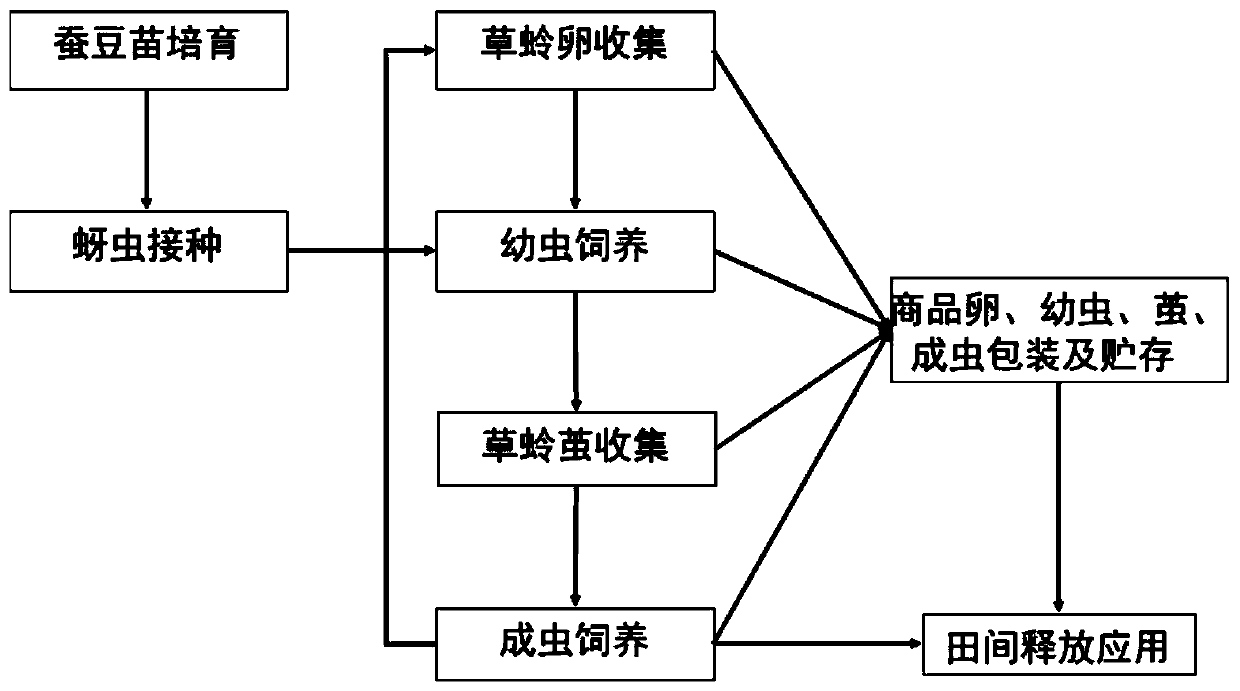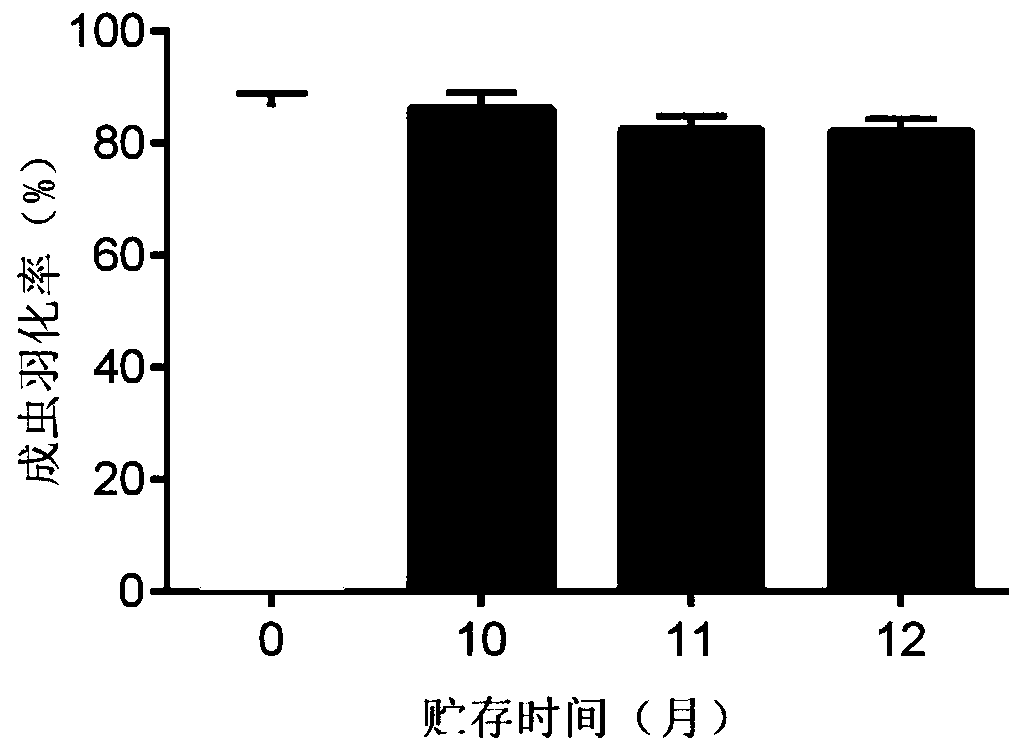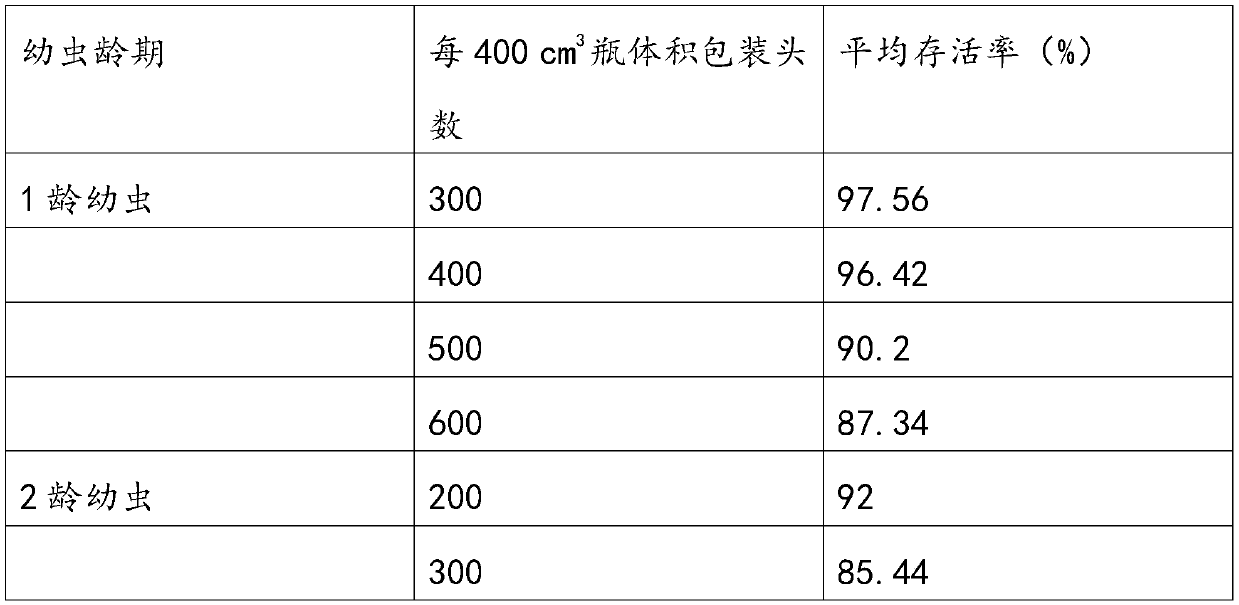Chrysopa formosa packaging and storing methods
A technology of packaging method and storage method, which is applied in the field of biological control of agricultural pests, can solve problems such as food safety, increased use of pesticides, and enhanced resistance of aphids to achieve high space utilization, full use of space, and increased shelf life. Effect
- Summary
- Abstract
- Description
- Claims
- Application Information
AI Technical Summary
Problems solved by technology
Method used
Image
Examples
Embodiment 1
[0052] The large-scale propagation of embodiment 1 pea aphid
[0053] 1.1 Host plant cultivation
[0054] After screening, the broad bean variety that is the natural king was selected as the host plant for the expansion and propagation of the pea aphid. Excellent host plants for aphids.
[0055] The specific steps of using broad bean seedlings to raise aphids on a large scale are as follows: under the conditions of 25±1°C indoors and a photoperiod of 16L:8D (16 hours of light during the day and 8 hours of darkness at night), feed the aphids to 24-hole seedling pots (30×20×10cm) Put the sterilized vermiculite inside, the thickness of the vermiculite is about 2.5cm, flatten the vermiculite to make the filling slightly tight, screen a large and plump broad bean seed and sprinkle it evenly on the vermiculite, each pot is divided according to every 600cm 2 The ratio of sowing 200-220 grains of broad beans is carried out to raise seedlings, and evenly spread a layer of vermiculite...
Embodiment 2
[0060] The scale propagation of embodiment 2 Lacewing
[0061] 2.1 Management and hatching of Lacewing eggs
[0062] Under the indoor conditions of 26±1°C and 16L:8D, the adults were placed in pitcher cages (60×60×60cm) and reared with P. pea for successive generations to establish a stable population. From the spawning day of newly emerged adults, new eggs were regularly collected every day, and the eggs were placed in a rearing box (30 cm) with folded filter paper strips (length 30 cm × width 1.5 cm, to prevent lacewing larvae from killing each other) at the bottom. ×20cm×10cm). like figure 1 As shown, the breeding box includes a box body 1 and a box cover 2; the top of the box body 1 is open, and a folded filter paper strip 3 is arranged inside the box body 1; the box cover 2 is covered on the top of the box body 1; the middle of the box body 2 is cut open A rectangular through hole (20cm×12cm) is covered with a gauze 4 made of 60-mesh nylon material, and the gauze 4 has...
Embodiment 3
[0069] The packaging and storage of embodiment 3 lacewing products
[0070] According to the production demand, under the premise of ensuring the regular multiplication of Lacewings, the eggs, larvae, cocoons and adults of Lacewings produced can be used for a variety of aphids, mites, thrips, scale insects and Lepidoptera pests in the field etc. prevention and treatment. In order to facilitate the transportation and application of the product, each insect form of Lacewing should be packaged before use. The packaging method is as follows.
[0071] 3.1 Packaging of lacewing eggs
[0072] The lacewing ovum is cut from the ovum stalk, collected in a glass petri dish (9 cm in diameter), and then with a soft hair brush, the ovum is gently swept to a removable area pasted with double-sided adhesive tape (long 4 cm, wide 3 cm). Fold the two sides of a rectangular three-dimensional paper card (13cm in length and 4cm in width) into a ridge shape in half, and leave a circular hole with...
PUM
| Property | Measurement | Unit |
|---|---|---|
| Thickness | aaaaa | aaaaa |
| Bottom diameter | aaaaa | aaaaa |
| Top diameter | aaaaa | aaaaa |
Abstract
Description
Claims
Application Information
 Login to View More
Login to View More - R&D
- Intellectual Property
- Life Sciences
- Materials
- Tech Scout
- Unparalleled Data Quality
- Higher Quality Content
- 60% Fewer Hallucinations
Browse by: Latest US Patents, China's latest patents, Technical Efficacy Thesaurus, Application Domain, Technology Topic, Popular Technical Reports.
© 2025 PatSnap. All rights reserved.Legal|Privacy policy|Modern Slavery Act Transparency Statement|Sitemap|About US| Contact US: help@patsnap.com



